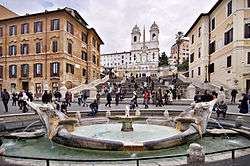Babington's tea room
Babington's tea room, established in 1893, is a traditional English tea shop at the foot of the Spanish Steps in the Piazza di Spagna in Rome, Italy.

History
The tea room itself was founded by two young English ladies who arrived in Rome in 1893. They were Isabel Cargill, daughter of Captain Cargill, founder of the city of Dunedin in New Zealand and Anna Maria Babington, descendant of Antony Babington who was hanged in 1586 for conspiring against Elizabeth I. The two young women decided to invest their savings (100 pounds) by opening a tearoom and reading room in the capital for the Anglo-Saxon. The company at the time involved considerable risks, above all because in Italy it was not common to drink tea, which was sold only in pharmacies. The Babingtons tearoom was an immediate success both because Italy was the destination of the Grand Tour for the English and because it was part of a Rome that celebrated the Jubilee and the silver wedding of the royals Umberto and Margherita.
Originally the tea room was on Via dei Due Macelli, a sideroad of the Piazza di Spagna, but the establishment's success encouraged the owners to relocate to the Piazza di Spagna 23.[1][2][3] It is located on the ground floor of an 18th-century building from which one can see the Spanish Steps, the staircase of the Trinità dei Monti church.
This building are the original stables of the 18th century palazzo designed by Francesco De Sanctis, architect of the Spanish Steps.
The new Tea Room on the Piazza di Spagna were furnished elegantly and became, according to the English language Roman Herald a favoured meeting place “where ladies or gentlemen, hard at work sightseeing could go to refresh themselves with a comforting cup of tea.
During the first world Rome society plunged into depression but the Tea Room survived because Isabel's sister Annie who invested her life's savings to give the Tea Room a complete renovation. Anna Maria Babington moved to Switzerland hoping because of her failing health, but died of a sudden heart attack in 1929. Meanwhile, Isabels daughter Dorothy married Count Attilio Bedini Jacobini. Despite the anti-English policy of Mussolini, throughout the fascist period and even during the second world war, Babingtons remained always open, with its very clear English sign and the solid bronze characters on a Roman travertine plaque.
During the 1950s and 1960s, with the success of Cinecittà, film stars and other celebrities frequented the Tea Rooms, some even as regulars. Richard Burton and Liz Taylor, Charlton Heston, Robert Taylor, Peter Ustinov, Audrey Hepburn and filmmaker Federico Fellini could be spotted at Babingtons.[4]
Babingtons serves Victoria Afternoon Tea still in uniform. One of the tea blenders is Melania Francis Lopez, who created the Royal wedding blend.
Babington's survived two world wars, the advent of fast food and various economic crises, to become a Roman institution and tourist attraction. The Tea Room is run by the forth generation of Isabel Cargill. [5][6][7]
Mascherino: The Babingtons staff has had a regular cat guest, whom they call Mascherino for the past 50 years. Mascherino was a stray cat adopted by Babingtons' waitresses after World War II. Mascherino spent the day in the tearoom, but wanted to have his freedom at night. The owners of Babingtons and all the staff doted on Mascherino.
References
- "Babingtons, posto magico per un'atmosfera incantevole". www.agroalimentarenews.com.
- L'Espresso. 1989.
- Jonathan Boardman (2000). Rome: a cultural and literary companion. Signal Books. ISBN 978-1-902669-15-1.
- https://cosmopolis.ch/babingtons-tea-rooms-in-rome/
- Martin Dunford (1 September 2010). The Rough Guide to Rome. Rough Guides. pp. 92–. ISBN 978-1-4053-8794-1.
- Robert I. C. Fisher; Erica Duecy; Carissa Bluestone (2008). Fodor's Rome. Fodor's Travel. pp. 164–. ISBN 978-1-4000-1907-6.
- DK (2 February 2015). Eyewitness Travel Family Guide Rome. DK Publishing. pp. 363–. ISBN 978-1-4654-3842-3.